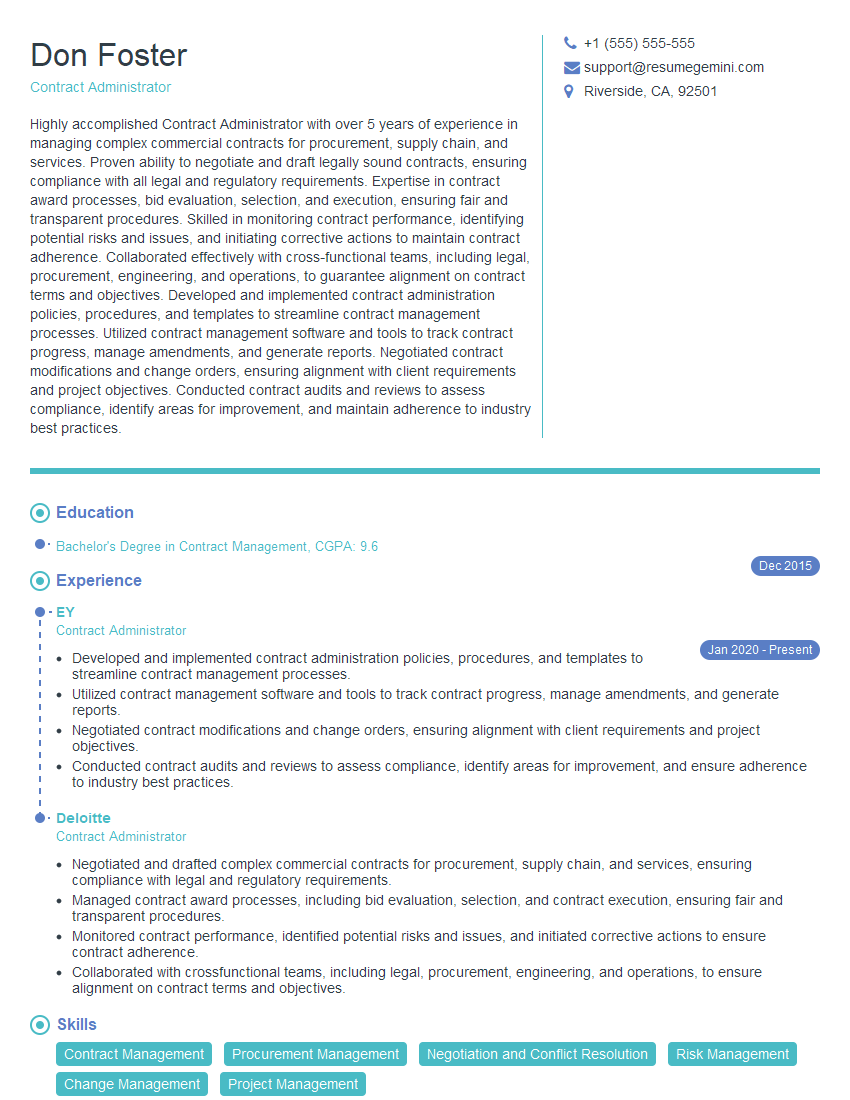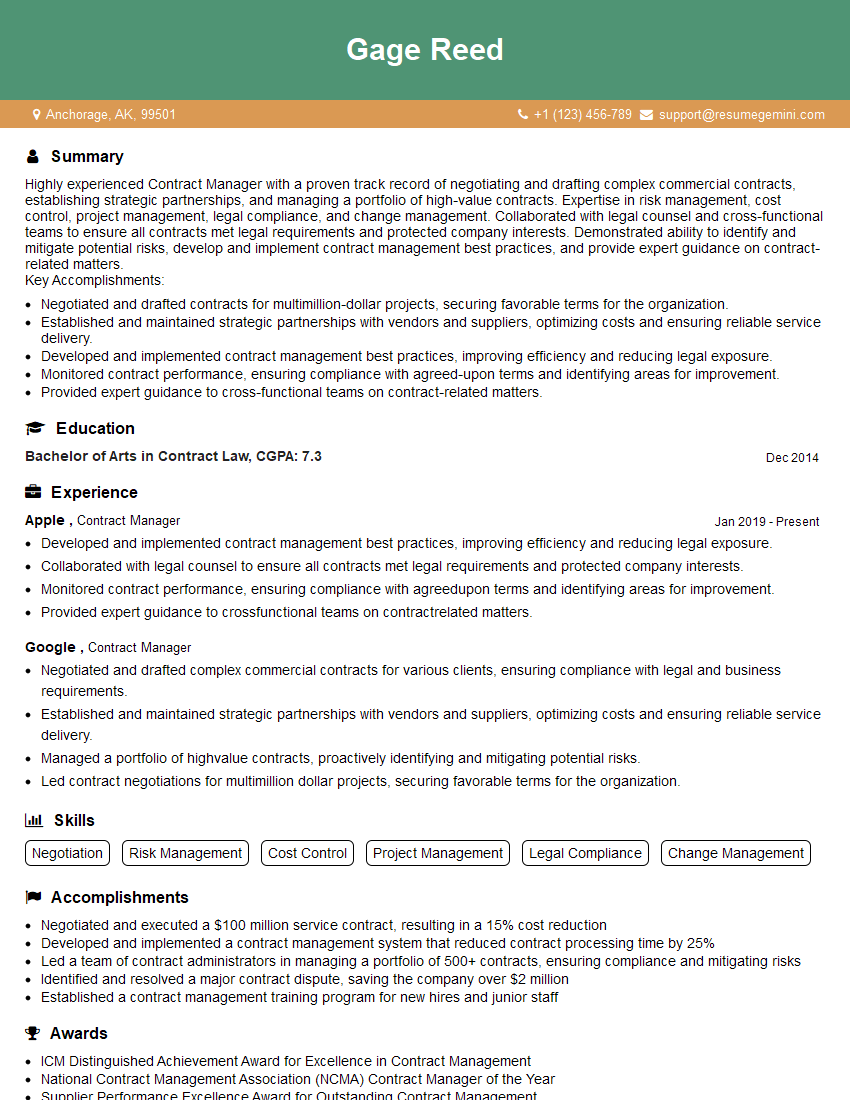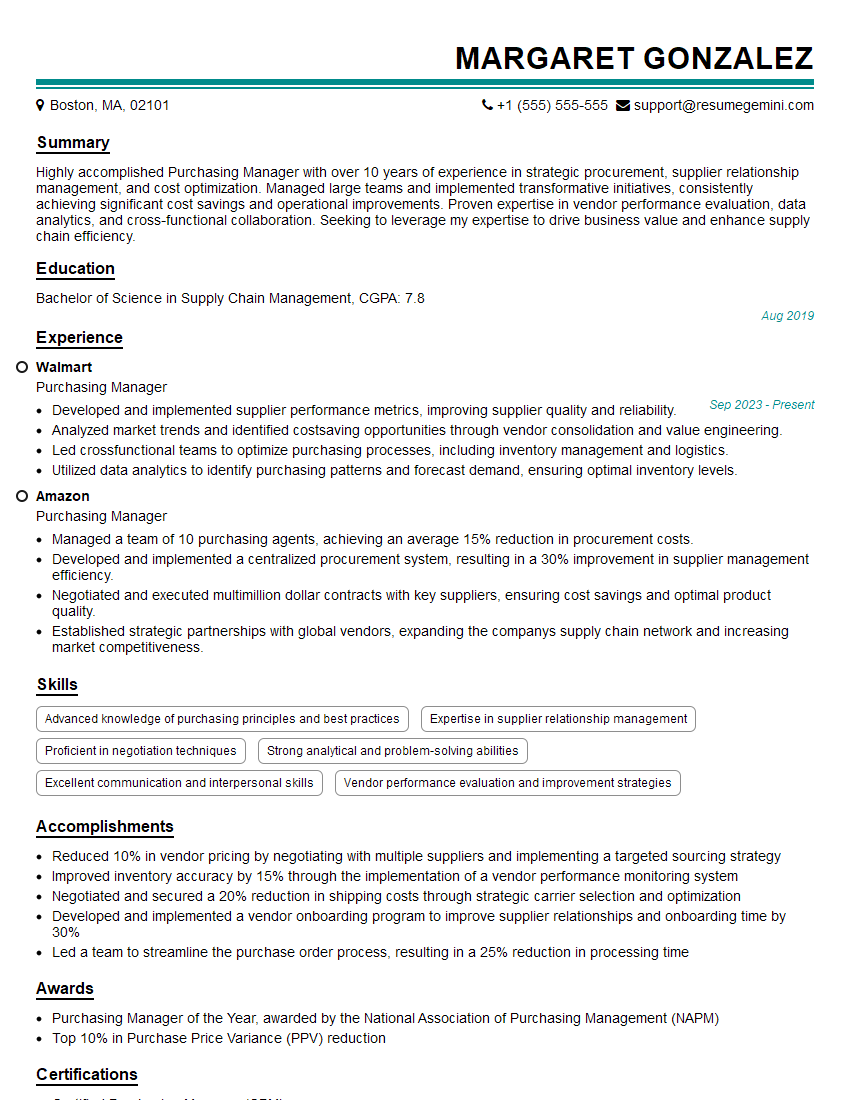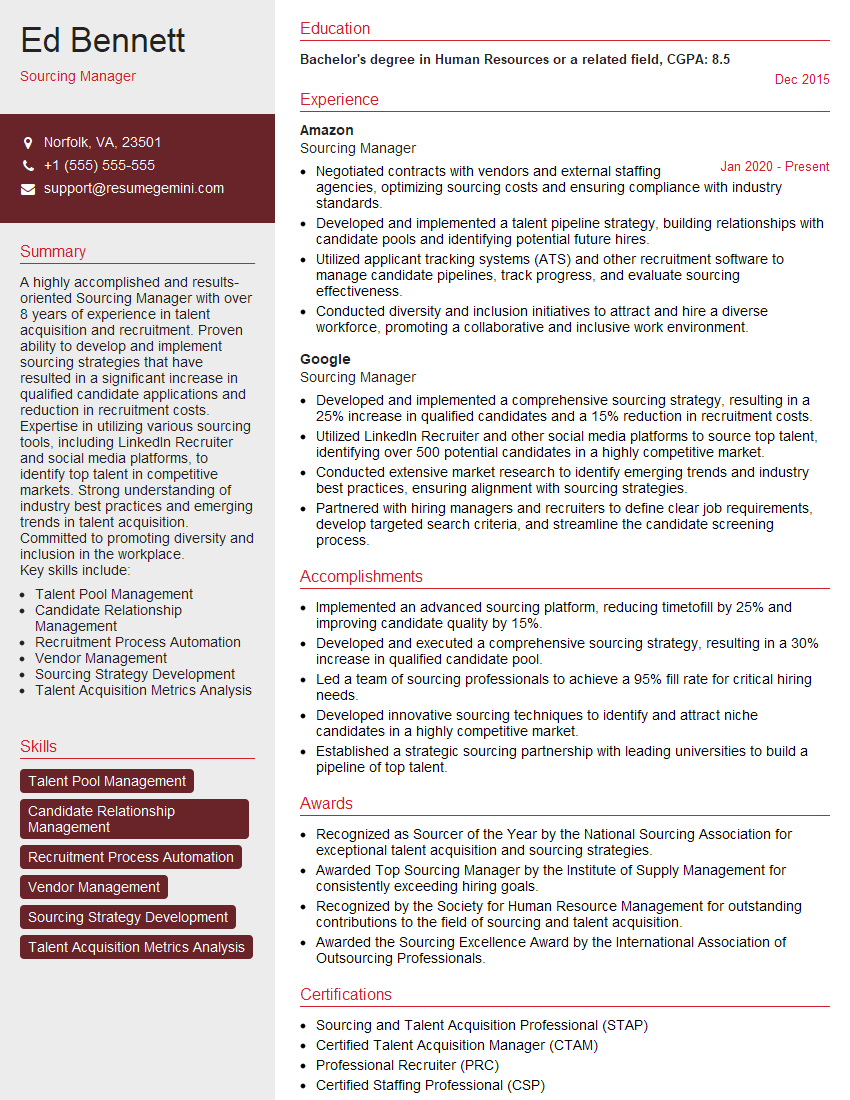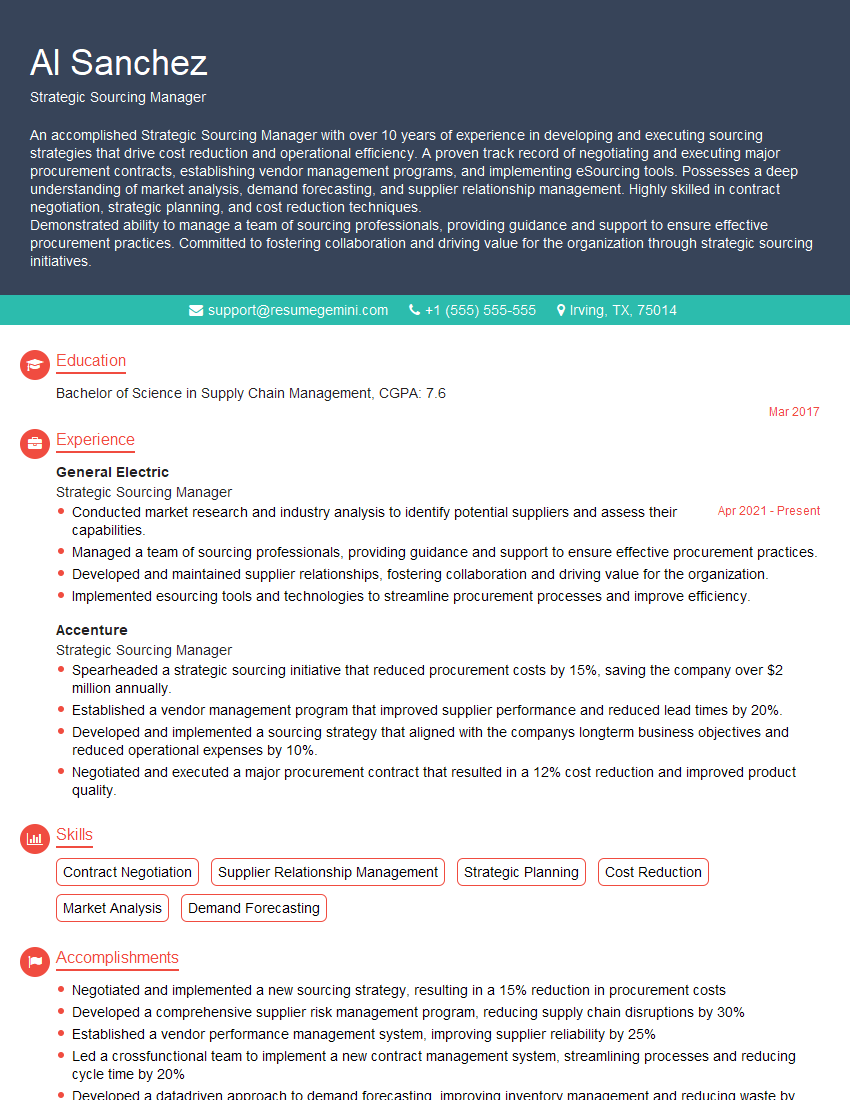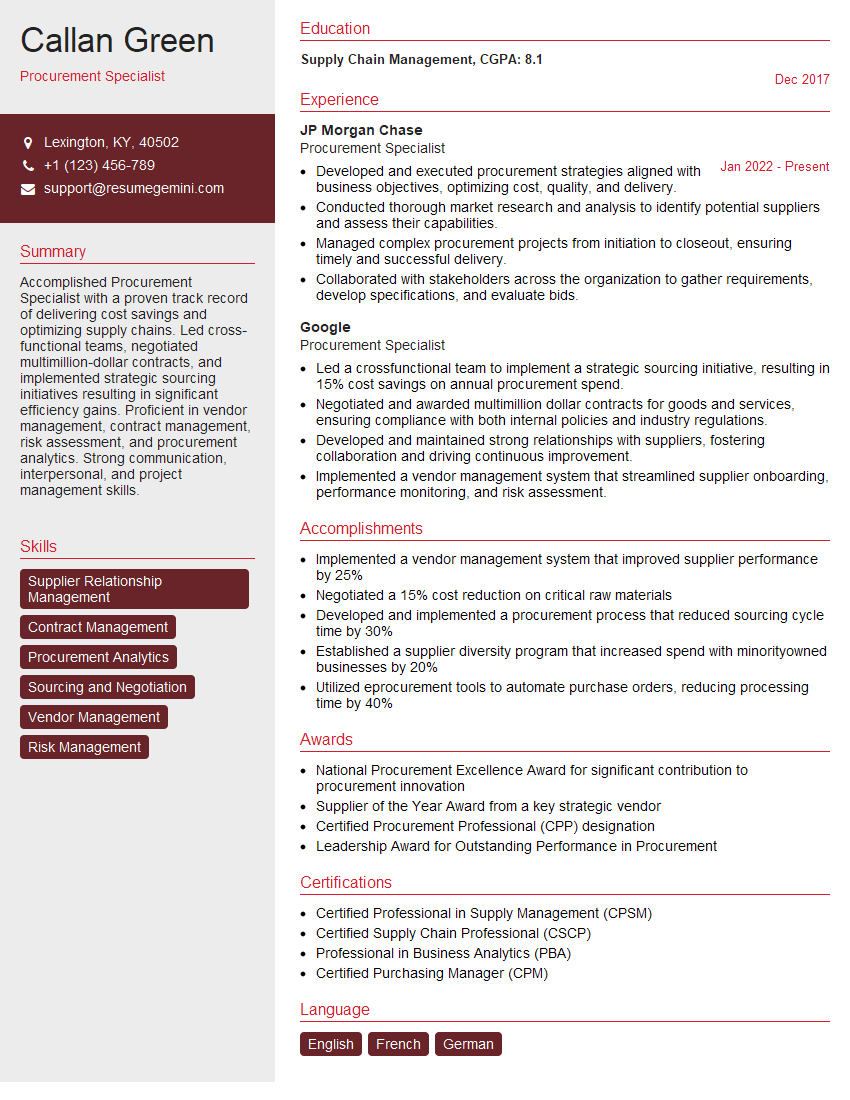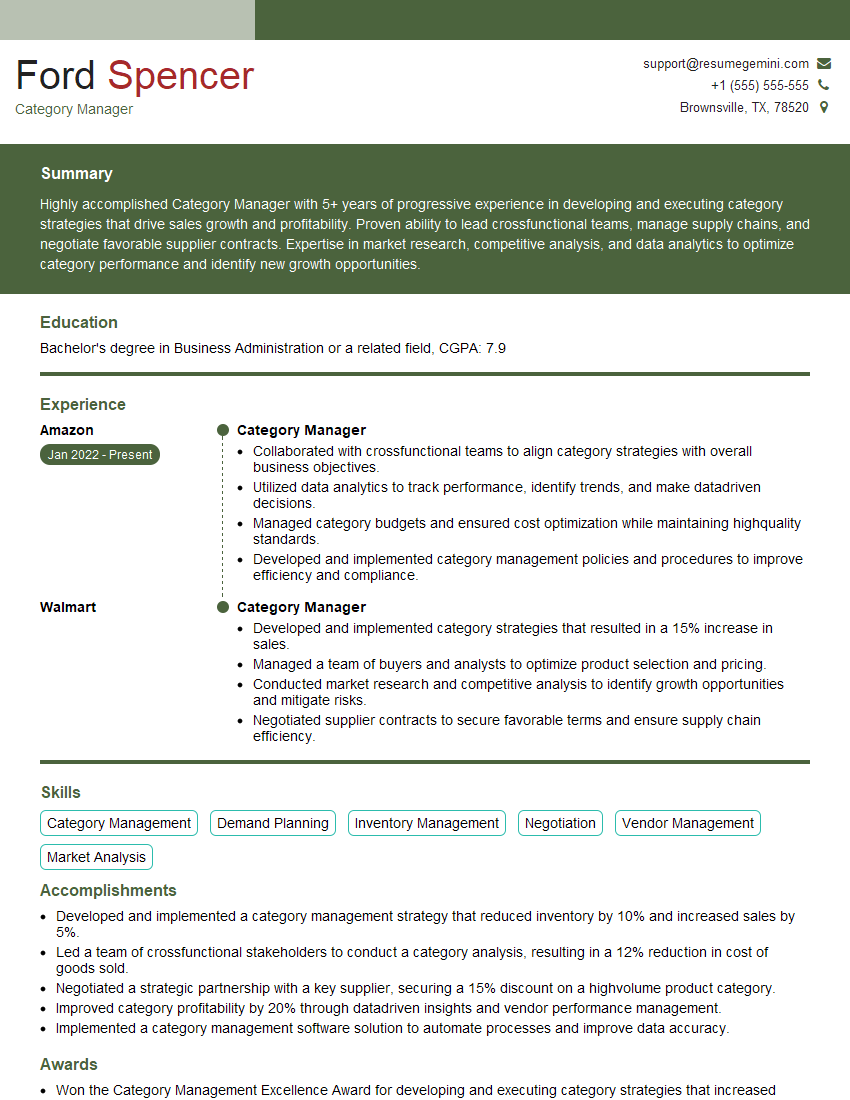Feeling uncertain about what to expect in your upcoming interview? We’ve got you covered! This blog highlights the most important Experience with Vendor Management and Procurement interview questions and provides actionable advice to help you stand out as the ideal candidate. Let’s pave the way for your success.
Questions Asked in Experience with Vendor Management and Procurement Interview
Q 1. Describe your experience with different sourcing strategies (e.g., competitive bidding, reverse auctions).
Sourcing strategies are crucial for finding the best vendors at optimal prices. I’ve extensive experience with several, including competitive bidding and reverse auctions. Competitive bidding involves sending out requests for proposals (RFPs) to multiple vendors, comparing their offers based on pre-defined criteria, and selecting the most advantageous one. Think of it like a silent auction – everyone submits their best offer without knowing what others are proposing. This ensures transparency and fair pricing. Reverse auctions, on the other hand, are more dynamic. Vendors actively bid against each other in real-time, driving down prices. This is best for standardized goods or services where price is the primary differentiator. In practice, I often employ a hybrid approach, using competitive bidding for complex projects requiring detailed proposals and reverse auctions for simpler, commodity-based purchases. For instance, when procuring software licenses for our company, I used a competitive bidding process, carefully analyzing proposals based on features, pricing, and support. For office supplies, however, reverse auctions were more effective, leading to significant cost savings.
Q 2. Explain your process for vendor selection and evaluation.
My vendor selection process is a multi-stage evaluation designed to ensure we choose reliable and high-performing partners. It starts with identifying potential vendors through market research, referrals, and online databases. Next, we issue RFPs outlining our requirements and evaluation criteria. This stage is followed by a rigorous assessment process that involves: 1. Pre-qualification: We check financial stability, experience, and references. 2. Proposal evaluation: We score proposals based on factors such as price, quality, delivery timelines, and risk mitigation strategies. 3. Site visits and presentations: We conduct site visits to assess facilities and capabilities and request presentations to clarify aspects of their proposals. 4. Reference checks: We contact previous clients to gauge their experiences. 5. Negotiation: Once a preferred vendor is identified, we negotiate contract terms and conditions. Finally, we conduct a thorough background check to ensure compliance with all applicable laws and regulations. For example, when selecting a cloud service provider, we carefully evaluated their security protocols, service level agreements (SLAs), and disaster recovery plans as part of our due diligence. This rigorous approach minimizes risk and maximizes the chances of a successful partnership.
Q 3. How do you manage vendor performance and address underperformance?
Vendor performance management is an ongoing process. It begins with establishing clear service level agreements (SLAs) that define expectations and key performance indicators (KPIs). We then monitor vendor performance against these SLAs on a regular basis, using dashboards and reporting tools. If underperformance occurs, we initiate a structured approach: 1. Early warning system: We identify and address minor issues proactively. 2. Performance improvement plan (PIP): If the issues are more significant, we develop a PIP with the vendor, outlining specific improvement areas, timelines, and consequences of non-compliance. 3. Corrective action: We track progress and implement corrective actions, involving regular communication and collaboration. 4. Termination: If performance doesn’t improve despite our efforts, we initiate contract termination procedures. For instance, with a previous logistics vendor, we experienced delays in delivery. We worked collaboratively to create a PIP that included investing in additional resources and improving their route planning. This collaborative approach led to significant improvements in their performance.
Q 4. What key performance indicators (KPIs) do you use to measure vendor success?
Measuring vendor success requires a tailored set of KPIs, depending on the nature of the service or product. Some common KPIs include: On-time delivery: Percentage of orders or services delivered on time. Quality: Defect rate or customer satisfaction scores related to the vendor’s output. Cost: Price per unit, total cost of ownership, and cost savings compared to previous arrangements. Compliance: Adherence to contracts, regulations, and company policies. Responsiveness: Time taken to respond to queries and resolve issues. Innovation: Introduction of new technologies or processes that add value. Using these metrics, we create scorecards that allow for a holistic assessment of vendor performance and facilitate data-driven decisions. We regularly review these KPIs to ensure they remain relevant and effective in measuring vendor success.
Q 5. Describe your experience negotiating contracts with vendors.
Contract negotiation is a critical skill in vendor management. It requires a strategic approach focused on achieving a win-win outcome. My process includes: Preparation: Thoroughly understanding the vendor’s offerings, market rates, and our own needs. Clear communication: Communicating our requirements, expectations, and desired outcomes clearly and concisely. Value-based negotiation: Focusing on the value delivered rather than solely on price. Risk mitigation: Incorporating clauses addressing potential risks and liabilities. Documentation: Thoroughly documenting all agreements and terms. For example, when negotiating a contract with a software vendor, I focused on securing favorable terms for maintenance, support, and intellectual property rights. I also negotiated flexible payment terms to align with our budget cycle. The key to successful negotiation is preparation, clear communication, and a collaborative approach.
Q 6. How do you handle contract disputes or breaches?
Contract disputes and breaches are unfortunately part of vendor management. My approach emphasizes proactive conflict resolution. Early intervention: Identifying potential issues early and addressing them through open communication. Mediation: Attempting to resolve disputes through facilitated discussions. Arbitration/litigation: Resorting to formal dispute resolution processes only as a last resort. The emphasis is on preserving the business relationship where possible. However, if the breach is severe or irreparable, we will take appropriate legal action. For instance, when a vendor failed to meet agreed-upon delivery deadlines, we first initiated a dialogue to understand the reasons and jointly develop a recovery plan. When that failed, we invoked specific clauses within the contract, resulting in financial compensation for the delays.
Q 7. How do you ensure compliance with procurement policies and regulations?
Ensuring compliance is paramount in vendor management. This involves: Establishing clear policies and procedures: Defining clear guidelines on vendor selection, contract management, and performance monitoring. Regular audits: Conducting internal and external audits to ensure compliance with policies, regulations, and industry standards. Vendor training: Providing vendors with the necessary training to understand and comply with our requirements. Documentation and record-keeping: Maintaining comprehensive records of all vendor interactions, contracts, and performance data. Technology solutions: Employing e-procurement systems to automate and streamline processes, reducing the risk of errors and non-compliance. For instance, we use a centralized e-procurement system that ensures that all purchase orders are routed through appropriate approval workflows, adhering to our internal financial and regulatory controls. This layered approach reduces risks and ensures that all aspects of our vendor relationships are managed in accordance with relevant laws and internal policies.
Q 8. What is your experience with various contract types (e.g., fixed-price, time & materials)?
My experience spans a wide range of contract types, each suited to different project needs. Fixed-price contracts are ideal for projects with well-defined scopes and predictable requirements. The price is set upfront, minimizing cost uncertainty for both parties. For example, I’ve managed fixed-price contracts for software development where the deliverables and timelines were clearly specified. In contrast, Time & Materials (T&M) contracts are more flexible, best suited for projects with evolving requirements or where the full scope isn’t initially clear. The vendor charges for the time spent and materials used. I utilized T&M contracts effectively for a large-scale IT infrastructure project, where unforeseen complexities required adaptability. Finally, I have experience with Cost-Plus contracts, where the vendor’s costs are reimbursed, plus a predetermined fee or percentage. These are generally used for highly complex or innovative projects with significant uncertainty. Each contract type requires careful negotiation and risk assessment to protect the organization’s interests.
Q 9. Describe your experience with e-procurement systems.
I’m proficient in various e-procurement systems, including Ariba, Coupa, and SAP SRM. These systems streamline the entire procurement process, from requisitioning to payment. My experience includes using these systems to manage vendor catalogs, automate purchase orders, track invoices, and conduct online auctions. For instance, using Ariba’s catalog functionality significantly reduced processing time for routine purchases, freeing up our team to focus on strategic sourcing. E-procurement systems also improve transparency and auditability, ensuring compliance and minimizing the risk of fraud. Furthermore, I have experience integrating e-procurement systems with our ERP (Enterprise Resource Planning) system, which ensured seamless data flow across different departments. This integration improved data accuracy and reduced manual data entry.
Q 10. How do you build and maintain strong vendor relationships?
Building and maintaining strong vendor relationships is crucial for successful procurement. My approach is built on transparency, open communication, and mutual respect. I establish clear expectations upfront, regularly communicate project progress, and address concerns promptly. For example, during a recent project, a vendor faced unforeseen challenges. By proactively communicating and working collaboratively to find solutions, we not only maintained the project timeline but also strengthened our relationship. I also believe in fostering a collaborative partnership, viewing vendors as extensions of our team rather than just suppliers. Regular performance reviews, coupled with feedback mechanisms, ensure consistent high performance and early identification of potential issues. Finally, recognizing and rewarding excellent performance builds loyalty and encourages long-term partnerships.
Q 11. What is your approach to risk management in procurement?
My approach to risk management in procurement is proactive and multi-faceted. It begins with thorough due diligence during vendor selection, evaluating financial stability, technical capabilities, and reputation. I use a risk assessment matrix to identify and prioritize potential risks, considering factors like supply chain disruptions, quality issues, and contract breaches. For each identified risk, I develop mitigation strategies, which could include establishing contingency plans, negotiating performance guarantees, or diversifying suppliers. Regular monitoring and reporting on key risk indicators are crucial for early detection of emerging issues. For instance, during a period of geopolitical uncertainty, I implemented a strategy to diversify our sourcing for critical components, thereby mitigating the risk of supply chain disruptions. This proactive approach ensured business continuity.
Q 12. How do you manage vendor onboarding and offboarding processes?
Vendor onboarding and offboarding are critical processes that ensure smooth transitions. Onboarding includes a detailed checklist covering contract review, security clearances, system access, training, and initial performance goals. We use a standardized onboarding process to maintain consistency and efficiency, which minimizes the time it takes for new vendors to become operational. On the other hand, offboarding involves a structured process to ensure a smooth transition. This includes documenting outstanding tasks, transferring knowledge, returning assets, and conducting exit interviews. A standardized offboarding process ensures that projects aren’t disrupted and that intellectual property is protected. This approach is designed to ensure a seamless transition, regardless of the reason for termination.
Q 13. How do you identify and mitigate potential supply chain disruptions?
Identifying and mitigating potential supply chain disruptions requires a multi-pronged approach. First, we monitor global events and industry trends that may impact our suppliers. This includes geopolitical instability, natural disasters, and pandemics. Next, we maintain a diverse supplier base to reduce reliance on a single source. We also build strong relationships with key suppliers to enhance communication and collaboration. Furthermore, I encourage suppliers to develop robust business continuity plans and regularly review these plans with them. Finally, we utilize advanced analytics to forecast potential disruptions and adjust our procurement strategies proactively. For example, during the recent global chip shortage, our proactive monitoring and diversified sourcing allowed us to secure the necessary components with minimal impact to our production schedule.
Q 14. Describe your experience with supplier diversity programs.
I have significant experience working with supplier diversity programs. These programs aim to increase the participation of minority-owned, women-owned, veteran-owned, and disabled veteran-owned businesses in our supply chain. My approach includes actively seeking out and engaging with diverse suppliers, providing training and support to help them compete for contracts, and setting diversity goals and tracking progress. I also work closely with internal stakeholders to build awareness and support for supplier diversity initiatives. These initiatives not only promote social responsibility but also bring innovation and fresh perspectives to our procurement processes. Furthermore, participating in supplier diversity events and leveraging online resources helps us expand our pool of qualified diverse suppliers.
Q 15. How do you track and manage vendor spend?
Tracking and managing vendor spend requires a robust system combining technology and process. We typically leverage a procurement system (like SAP Ariba or Coupa) that integrates with our ERP. This allows for real-time visibility into all purchase orders, invoices, and payments.
My approach involves several key steps:
- Centralized Database: All vendor transactions are recorded in a single, accessible database. This eliminates data silos and allows for accurate reporting.
- Spend Categorization: We categorize spending by vendor, department, product/service, and other relevant criteria. This enables insightful analysis of spending patterns and helps identify areas for potential savings.
- Regular Reporting and Dashboards: We generate regular reports and dashboards that visualize key spending metrics. This allows for proactive identification of anomalies and potential issues.
- Spend Analysis: We conduct regular spend analysis to identify areas of overspending, inefficient processes, or opportunities for consolidation with fewer vendors.
For example, in a previous role, we implemented a new procurement system that drastically improved our spend visibility. We were able to identify a significant amount of duplicate spending on similar services from different vendors, leading to immediate cost savings through consolidation.
Career Expert Tips:
- Ace those interviews! Prepare effectively by reviewing the Top 50 Most Common Interview Questions on ResumeGemini.
- Navigate your job search with confidence! Explore a wide range of Career Tips on ResumeGemini. Learn about common challenges and recommendations to overcome them.
- Craft the perfect resume! Master the Art of Resume Writing with ResumeGemini’s guide. Showcase your unique qualifications and achievements effectively.
- Don’t miss out on holiday savings! Build your dream resume with ResumeGemini’s ATS optimized templates.
Q 16. What is your experience with total cost of ownership (TCO) analysis?
Total Cost of Ownership (TCO) analysis goes beyond the initial purchase price to consider all direct and indirect costs associated with a product or service throughout its lifecycle. It’s a crucial tool for making informed procurement decisions.
My experience includes performing TCO analysis for various procurements, including software licenses, IT hardware, and consulting services. This involves:
- Identifying all cost elements: This includes acquisition costs, implementation costs, operating costs (e.g., maintenance, support, energy consumption), and disposal costs.
- Quantifying each cost element: We use data from various sources, including vendor quotes, internal cost accounting, and industry benchmarks.
- Developing a TCO model: We create a model to project the total cost over the asset’s lifetime. This may involve using spreadsheets or specialized software.
- Comparing different options: We compare the TCO of different vendors or products to determine the most cost-effective option.
For instance, in one project, a TCO analysis revealed that a seemingly cheaper software solution had significantly higher ongoing maintenance costs, making a slightly more expensive, but more efficient option, the more economical choice in the long run.
Q 17. How do you ensure data accuracy and integrity in procurement processes?
Data accuracy and integrity are paramount in procurement. Errors can lead to financial losses, compliance issues, and damaged vendor relationships. My approach involves a multi-layered strategy:
- Data Validation: We implement robust data validation checks at every stage of the procurement process, from purchase requisition to invoice processing. This involves automated checks and manual verification.
- Standardized Processes: Clear, standardized processes and workflows minimize errors and inconsistencies. We utilize pre-approved templates and checklists to guide users through each step.
- Data Cleansing and Reconciliation: We regularly cleanse and reconcile data to identify and correct discrepancies. This includes comparing data from different systems and resolving inconsistencies.
- System Audits and Controls: Regular system audits and internal controls help ensure data accuracy and integrity. This includes reviewing user access rights, monitoring system logs, and conducting periodic data checks.
- Training and Awareness: Comprehensive training for procurement staff on data entry and process adherence is crucial.
Think of it like building a house – a strong foundation (standardized processes) and regular inspections (audits) are vital to ensuring the structure (data integrity) remains sound.
Q 18. Describe your experience with cost-saving initiatives in procurement.
I have a proven track record of implementing cost-saving initiatives in procurement. These initiatives typically focus on several key areas:
- Negotiation and Strategic Sourcing: Developing strong relationships with vendors and leveraging our collective buying power to negotiate better pricing and terms. This often involves competitive bidding processes and exploring alternative sourcing options.
- Spend Analysis and Optimization: Identifying areas of overspending and inefficiencies through detailed spend analysis. This often leads to opportunities for consolidation, bulk purchasing, and improved contract terms.
- Process Improvement: Streamlining procurement processes to reduce administrative overhead and improve efficiency. This can include automating tasks, improving workflows, and reducing manual data entry.
- Supplier Relationship Management (SRM): Building strong relationships with key suppliers to foster collaboration and ensure consistent quality and timely delivery. This often leads to preferential pricing and early access to new technologies.
In one instance, I led a team that renegotiated contracts with several key suppliers, resulting in a 15% reduction in annual procurement costs. This involved thorough market research, robust negotiation strategies, and a clear understanding of our leverage within the market.
Q 19. How do you prioritize vendor requirements and manage competing demands?
Prioritizing vendor requirements and managing competing demands requires a structured approach. I typically use a combination of methods:
- Prioritization Matrix: I use a prioritization matrix that considers factors such as urgency, importance, risk, and impact. This helps to objectively rank vendor requirements and allocate resources effectively.
- Stakeholder Engagement: Regular communication and collaboration with stakeholders (e.g., internal departments, senior management, vendors) are essential to ensure that everyone understands the priorities and timelines.
- Negotiation and Conflict Resolution: Effective negotiation skills are critical to resolving conflicting demands and finding mutually acceptable solutions. This involves active listening, clear communication, and finding creative compromises.
- Project Management Tools: Leveraging project management tools and techniques helps to track progress, manage deadlines, and ensure accountability.
Imagine it like air traffic control – managing many different ‘flights’ (vendor requirements) requires careful coordination and prioritization to avoid collisions (conflicts) and ensure a smooth operation.
Q 20. What is your experience with implementing new procurement technologies?
I have extensive experience implementing new procurement technologies, ranging from e-procurement systems to contract management platforms. My approach involves:
- Needs Assessment: Clearly defining the business needs and objectives for implementing the new technology. This involves identifying pain points, desired outcomes, and key performance indicators (KPIs).
- Vendor Selection: A thorough evaluation of different vendors and their solutions, considering factors such as functionality, cost, scalability, and integration with existing systems.
- Implementation Planning: Developing a detailed implementation plan that outlines timelines, resources, and responsibilities. This plan includes change management strategies to ensure user adoption.
- Training and Support: Providing comprehensive training and ongoing support to users to ensure successful adoption and ongoing utilization of the new technology.
- Testing and Go-Live: Rigorous testing of the system before go-live to identify and resolve any issues. A phased rollout approach can help minimize disruption.
In a previous role, we successfully implemented a new e-procurement system, resulting in a significant reduction in processing time and improved compliance. This involved careful planning, thorough user training, and close collaboration with the vendor.
Q 21. How do you conduct vendor due diligence?
Vendor due diligence is a critical process to mitigate risk and ensure that we partner with reliable and ethical vendors. My approach involves a thorough assessment across several key areas:
- Financial Stability: Reviewing the vendor’s financial statements, credit reports, and other financial information to assess their financial health and stability.
- Operational Capabilities: Evaluating the vendor’s operational capabilities, including their infrastructure, processes, and technology. This often involves site visits and discussions with key personnel.
- Compliance and Legal: Verifying the vendor’s compliance with relevant laws and regulations, including environmental, labor, and anti-corruption laws. This includes reviewing licenses and permits.
- Reputation and References: Checking the vendor’s reputation through online research, reviews, and references from other clients. This can reveal past performance and any potential red flags.
- Security and Data Protection: Assessing the vendor’s security measures and data protection policies to ensure the confidentiality and integrity of our sensitive information.
Think of it as a background check for a potential business partner. A comprehensive due diligence process ensures that we choose vendors that meet our high standards of quality, ethics, and reliability.
Q 22. Describe your experience with managing vendor contracts across multiple geographies.
Managing vendor contracts across multiple geographies requires a nuanced approach that considers legal, cultural, and logistical differences. It’s not just about translating a contract; it’s about understanding the nuances of each region’s business practices and legal frameworks.
In my previous role, we had vendors in North America, Europe, and Asia. We established a standardized contract template that addressed core elements, like intellectual property rights, payment terms, and service level agreements (SLAs). However, each regional version incorporated clauses specific to local laws and regulations. For example, data privacy regulations like GDPR in Europe required specific clauses related to data handling and security that weren’t needed in other regions. We also used a centralized contract management system to track all contracts, ensuring consistent oversight and preventing discrepancies. This involved regular reviews, updates, and collaboration with legal teams in each region to ensure compliance.
Successfully navigating this complexity requires strong communication, collaboration with in-country legal counsel, and a deep understanding of international business practices. It’s about finding a balance between standardization for efficiency and localization for legal and cultural appropriateness.
Q 23. What is your experience with different types of procurement (direct vs. indirect)?
Procurement is broadly categorized into direct and indirect procurement. Direct procurement involves goods or services directly related to the production of a company’s core product or service. Think raw materials for a manufacturer or components for a technology company. Indirect procurement covers all other goods and services needed to run the business, such as office supplies, IT services, or travel arrangements.
My experience encompasses both. In direct procurement, I’ve focused on negotiating favorable pricing and delivery terms with suppliers, ensuring timely delivery and quality control. This often involves a high degree of collaboration with the production team to ensure alignment. For example, working with a supplier of specialized microchips ensured that we met production demands while mitigating supply chain risks.
Indirect procurement demands a different strategy; it’s about cost optimization and efficiency. This includes consolidating purchases, using e-procurement systems, and exploring alternative sourcing options. For instance, leveraging bulk buying power for office supplies, or switching to a cloud-based solution for a more cost-effective IT infrastructure. Both aspects require strong analytical skills, market knowledge, and effective vendor relationship management.
Q 24. How do you ensure transparency and accountability in procurement processes?
Transparency and accountability are paramount in procurement. We achieve this through a multi-pronged approach that involves clear processes, robust documentation, and a commitment to ethical conduct.
Firstly, all procurement activities are documented in a centralized system. This includes request for proposals (RFPs), vendor selections, contract negotiations, and payment records. This creates an audit trail, ensuring that all decisions are traceable and justifiable. Secondly, we use a competitive bidding process to ensure fair pricing and prevent favoritism. This involves establishing clear selection criteria, and documenting the evaluation process.
Regular internal audits further enhance transparency and accountability. These audits verify that procurement processes are followed, ensuring compliance with company policies and regulations. Finally, open communication and regular reporting to stakeholders maintain trust and demonstrate our commitment to ethical and transparent practices. Transparency doesn’t just build trust; it improves efficiency and reduces the risk of errors or misconduct.
Q 25. How do you handle ethical dilemmas in procurement?
Ethical dilemmas in procurement can range from conflicts of interest to bribery and corruption. My approach is guided by a strict adherence to company policies, industry best practices, and relevant laws. The first step is always to identify and assess the potential ethical implications of a situation.
For instance, if a vendor offers an unusually attractive deal or gift, I would carefully investigate to rule out any undue influence or bribery attempt. Documentation is crucial; any suspicious interactions are thoroughly documented and reported according to company protocol. Our code of conduct clearly outlines acceptable practices and consequences of violations. If faced with a difficult situation, we have established internal reporting mechanisms and legal advice to guide us through the proper course of action.
Ethical procurement isn’t just about avoiding legal trouble; it’s about building trust with vendors and fostering a positive reputation. A strong ethical foundation builds long-term relationships based on mutual respect and fairness.
Q 26. What is your experience with developing and implementing procurement strategies?
Developing and implementing procurement strategies is a crucial part of my role. It requires a deep understanding of the organization’s strategic goals and market conditions.
A typical strategy begins with a thorough assessment of current procurement processes, identifying strengths, weaknesses, and areas for improvement. This includes analyzing spending patterns, identifying key suppliers, and evaluating the effectiveness of existing contracts. Based on this analysis, we define clear objectives for the procurement function. These might include cost reduction, improving supplier relationships, or enhancing risk management.
Next, we develop strategies to achieve these objectives. This could involve implementing new technologies, such as e-procurement systems, exploring new sourcing strategies, and developing strong vendor relationships. For example, we might implement a supplier relationship management (SRM) system to better manage key vendors, improving collaboration and performance. Continuous monitoring and performance evaluation are essential to ensure the strategy remains aligned with business needs and market changes.
Q 27. Describe a time you had to negotiate a difficult contract. What was the outcome?
One particularly challenging negotiation involved a critical software vendor that was demanding a significant price increase mid-contract. This was disruptive to our budget and project timelines.
My approach was threefold: First, I meticulously reviewed the contract, identifying clauses that could be leveraged. Second, I prepared a comprehensive presentation demonstrating the value we brought to the vendor as a key client and the negative impact of the price increase on our relationship. Finally, I explored alternative solutions, such as renegotiating the scope of work or exploring competing vendors. The negotiation involved several meetings and a lot of give and take. Ultimately, we reached a compromise: a smaller price increase than originally demanded, coupled with an extension of the contract term, delivering a favorable outcome for both parties.
This experience highlighted the importance of thorough contract review, robust data-backed arguments, and creativity in finding mutually beneficial solutions. Building strong relationships with vendors is also key; sometimes, the best deals are born out of mutual trust and collaboration.
Q 28. How do you stay current with best practices in vendor management and procurement?
Staying current with best practices in vendor management and procurement requires continuous learning and engagement with the industry.
I regularly attend industry conferences and webinars to learn about emerging trends and best practices. I actively participate in professional organizations like the Institute for Supply Management (ISM), engaging in networking and knowledge sharing. I also subscribe to industry publications and journals, remaining informed about changes in regulations and technology. Furthermore, I leverage online resources, industry reports, and case studies to stay up-to-date on current procurement strategies.
Continuous learning is essential in this field, as regulations, technologies, and best practices are constantly evolving. Staying informed enables me to bring innovative and effective solutions to my organization.
Key Topics to Learn for Experience with Vendor Management and Procurement Interview
- Vendor Selection & Qualification: Understanding the process of identifying, evaluating, and selecting suitable vendors based on criteria like cost, quality, reliability, and compliance. This includes developing robust RFPs (Request for Proposals) and evaluating vendor responses.
- Contract Negotiation & Management: Mastering the art of negotiating favorable contracts, understanding key contract clauses, and managing contract performance throughout the lifecycle. This involves risk mitigation and proactive issue resolution.
- Supplier Relationship Management (SRM): Building and maintaining strong relationships with key vendors to ensure consistent performance and collaboration. This includes regular communication, performance reviews, and collaborative problem-solving.
- Procurement Processes & Best Practices: Familiarity with various procurement methodologies (e.g., competitive bidding, reverse auctions) and understanding of ethical sourcing and sustainable procurement principles.
- Cost Management & Savings: Demonstrating experience in identifying cost-saving opportunities, negotiating favorable pricing, and implementing cost-control measures throughout the procurement process.
- Risk Management & Mitigation: Understanding potential risks associated with vendor relationships and implementing strategies to mitigate these risks, such as contract clauses, performance guarantees, and contingency planning.
- Technology & Tools: Experience with procurement software, e-procurement systems, and other relevant technologies used in vendor management and procurement processes.
- Compliance & Regulatory Requirements: Knowledge of relevant laws, regulations, and industry standards related to procurement and vendor management (e.g., ethical sourcing, data privacy).
- Performance Measurement & Reporting: Tracking key performance indicators (KPIs) to monitor vendor performance and providing regular reports to stakeholders.
- Problem-Solving & Decision-Making: Demonstrating the ability to identify and solve problems efficiently, make sound decisions under pressure, and adapt to changing circumstances.
Next Steps
Mastering vendor management and procurement significantly enhances your career prospects, opening doors to leadership roles and higher earning potential. A strong resume is crucial for showcasing your expertise. Creating an ATS-friendly resume significantly increases your chances of getting noticed by recruiters. We recommend using ResumeGemini, a trusted resource, to build a professional and impactful resume. ResumeGemini provides examples of resumes tailored specifically to Experience with Vendor Management and Procurement to help you craft a compelling application.
Explore more articles
Users Rating of Our Blogs
Share Your Experience
We value your feedback! Please rate our content and share your thoughts (optional).
What Readers Say About Our Blog
Hello,
We found issues with your domain’s email setup that may be sending your messages to spam or blocking them completely. InboxShield Mini shows you how to fix it in minutes — no tech skills required.
Scan your domain now for details: https://inboxshield-mini.com/
— Adam @ InboxShield Mini
Reply STOP to unsubscribe
Hi, are you owner of interviewgemini.com? What if I told you I could help you find extra time in your schedule, reconnect with leads you didn’t even realize you missed, and bring in more “I want to work with you” conversations, without increasing your ad spend or hiring a full-time employee?
All with a flexible, budget-friendly service that could easily pay for itself. Sounds good?
Would it be nice to jump on a quick 10-minute call so I can show you exactly how we make this work?
Best,
Hapei
Marketing Director
Hey, I know you’re the owner of interviewgemini.com. I’ll be quick.
Fundraising for your business is tough and time-consuming. We make it easier by guaranteeing two private investor meetings each month, for six months. No demos, no pitch events – just direct introductions to active investors matched to your startup.
If youR17;re raising, this could help you build real momentum. Want me to send more info?
Hi, I represent an SEO company that specialises in getting you AI citations and higher rankings on Google. I’d like to offer you a 100% free SEO audit for your website. Would you be interested?
Hi, I represent an SEO company that specialises in getting you AI citations and higher rankings on Google. I’d like to offer you a 100% free SEO audit for your website. Would you be interested?
good
